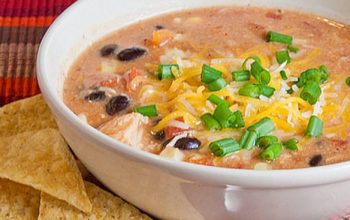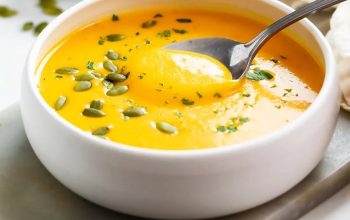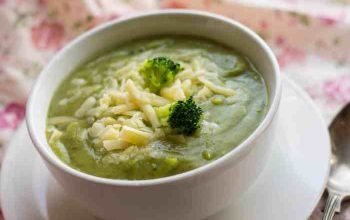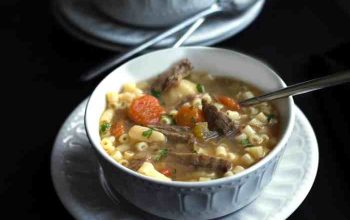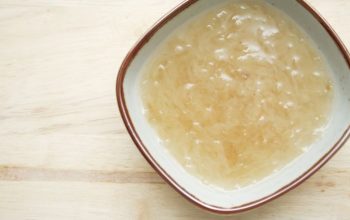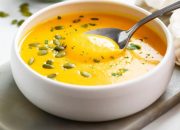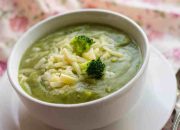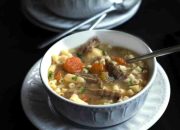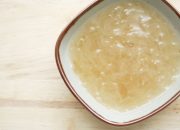Korean Seaweed Soup (Miyeokguk): A Jakarta South Guide
Seaweed soup korean recipe – Miyeokguk, or Korean seaweed soup, is more than just a delicious meal; it’s a cultural cornerstone, especially significant during birthdays and postpartum recovery. This deeply flavorful soup, a staple in Korean cuisine, boasts a surprising nutritional punch, making it a trendy and healthy choice even in the bustling culinary scene of South Jakarta. This guide dives into the world of Miyeokguk, from its cultural significance to advanced techniques for creating the perfect bowl.
Cultural Significance of Miyeokguk
In Korean culture, Miyeokguk holds a special place, traditionally served to celebrate birthdays and especially for mothers after childbirth. The seaweed is believed to aid in postpartum recovery due to its rich mineral content. Sharing a bowl of Miyeokguk is a powerful symbol of love, care, and celebration within Korean families. Its presence at significant life events underscores its deep-rooted cultural importance.
Common Miyeokguk Ingredients and Nutritional Benefits, Seaweed soup korean recipe
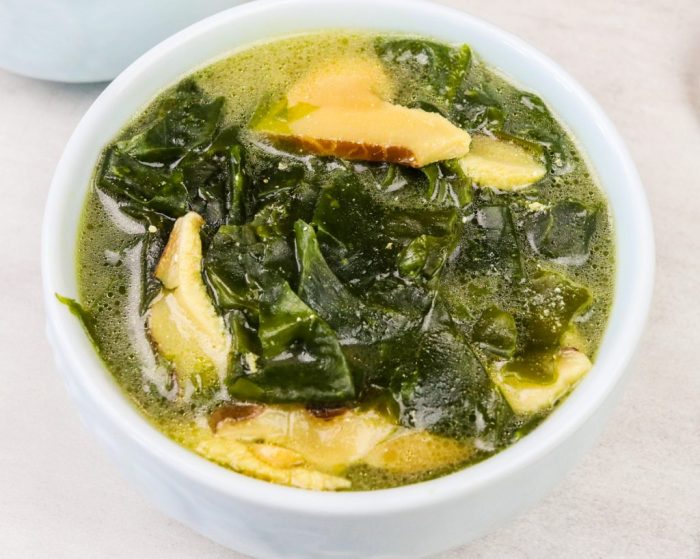
Source: thecheaplazyvegan.com
A basic Miyeokguk recipe typically includes dried seaweed (miyeok), beef broth (though vegetarian versions are common), soy sauce, garlic, and sometimes mushrooms or onions for added depth of flavor. Seaweed itself is a nutritional powerhouse, packed with vitamins, minerals, and antioxidants. It’s a great source of iodine, iron, and fiber, contributing to a balanced and healthy diet. The combination of ingredients creates a nutrient-rich soup that is both satisfying and beneficial.
Variations of Seaweed Soup Recipes
Miyeokguk isn’t a one-size-fits-all dish. Regional variations and personal preferences lead to diverse recipes. Some versions incorporate seafood like clams or anchovies, while others feature different types of seaweed, each impacting the soup’s flavor and texture. The cooking methods also vary, with some preferring a quick simmer while others opt for a longer, slower cooking process.
| Recipe Name | Key Ingredients | Cooking Method | Notable Features |
|---|---|---|---|
| Classic Beef Miyeokguk | Dried seaweed, beef broth, soy sauce, garlic, onions | Simmer beef broth, add seaweed and other ingredients, cook until seaweed softens | Rich, savory flavor; traditional preparation |
| Seafood Miyeokguk | Dried seaweed, clams, anchovies, soy sauce, garlic, gochujang (optional) | Sauté garlic, add seafood, then seaweed and broth; simmer until seafood is cooked | Umami-rich, briny flavor; lighter broth |
| Vegetarian Miyeokguk | Dried seaweed, vegetable broth, soy sauce, garlic, mushrooms, onions | Simmer vegetable broth, add seaweed and other ingredients, cook until seaweed softens | Hearty, savory, and completely plant-based |
Regional variations often involve the type of seaweed used or the addition of local ingredients. Coastal regions might utilize more readily available seafood, while inland areas might focus on vegetable-based broths and additions.
Step-by-Step Cooking Process of a Classic Miyeokguk Recipe
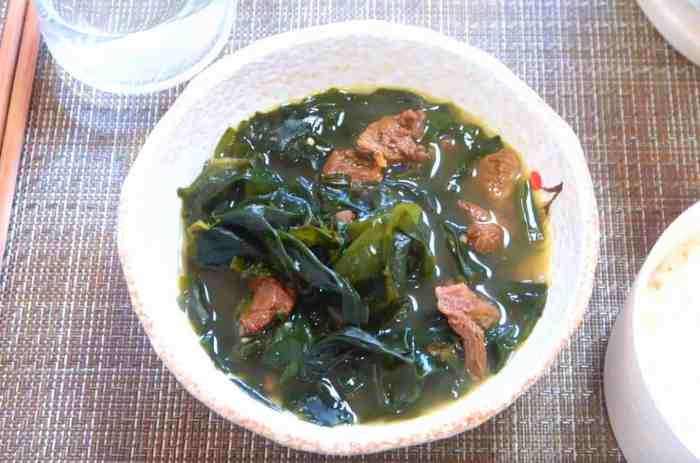
Source: futuredish.com
Creating a delicious Miyeokguk is simpler than you might think. Follow these steps for a classic version:
- Rinse the dried seaweed thoroughly under cold water to remove excess salt and impurities.
- In a pot, bring beef broth to a simmer.
- Add finely chopped garlic and onions (optional). Simmer for a few minutes to release their flavors.
- Add the soaked seaweed to the broth and simmer until tender, about 10-15 minutes. Adjust cooking time depending on the seaweed’s thickness.
- Season with soy sauce to taste. Add a pinch of salt if needed.
- Serve hot.
Infographic Description: The infographic would visually represent the steps above, perhaps using a series of icons or illustrations depicting each step. The color scheme would be warm and inviting, reflecting the soup’s comforting nature. A final image showcasing a steaming bowl of Miyeokguk would be the centerpiece.
Tips for optimal texture and flavor: Don’t overcook the seaweed; it should be tender but not mushy. Adjust seasoning carefully, tasting as you go. A touch of sesame oil at the end can add a nice nutty aroma.
Advanced Techniques and Flavor Enhancements
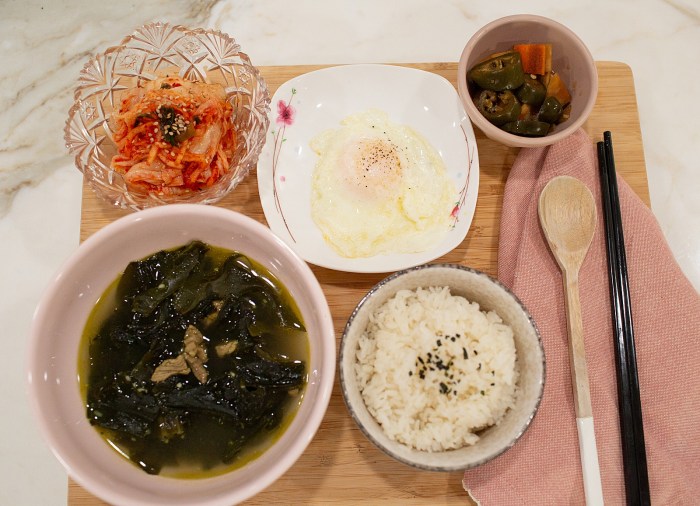
Source: mommy-diary.com
Beyond the classic recipe, you can elevate your Miyeokguk with various protein sources and flavor enhancers. Experimentation is key!
Incorporating protein: Adding thinly sliced beef, shredded chicken, or even seafood like shrimp or mussels can significantly enhance the richness and protein content of the soup.
Enhancing Umami: A dash of fish sauce or a few drops of mushroom extract can deepen the umami flavor profile. Adding a small amount of gochujang (Korean chili paste) can provide a subtle spicy kick.
Complementary Side Dishes: Miyeokguk pairs well with various side dishes, such as japchae (glass noodles with vegetables), kimchi, and steamed rice. These dishes complement the soup’s flavor profile and provide a balanced meal.
Serving and Presentation of Miyeokguk
Serving Miyeokguk is an art in itself. Proper serving temperature and presentation can elevate the dining experience.
Serving Temperature and Etiquette: Serve Miyeokguk piping hot in individual bowls. There are no strict etiquette rules beyond enjoying it with gusto!
Garnishing Ideas: A sprinkle of chopped green onions or a drizzle of sesame oil adds visual appeal and subtle flavor enhancements. A few pieces of thinly sliced chili can add a pop of color and a hint of spice.
Presentation Ideas: Serve in elegant bowls, perhaps with a simple side of kimchi or other complementary dishes arranged artfully on a platter. The overall presentation should be clean and inviting, highlighting the soup’s natural beauty.
User Queries: Seaweed Soup Korean Recipe
Can I use dried seaweed instead of fresh?
Yes, but be sure to rehydrate it properly according to package instructions. Dried seaweed will require longer cooking time.
What if I don’t have beef broth?
The rich, umami broth of Korean seaweed soup, a culinary treasure, offers a comforting warmth. For a taste of equally elegant, yet different creamy goodness, explore the delightful world of recipes with cream of asparagus soup , showcasing the subtle sweetness of asparagus. Returning to the seaweed soup, remember its versatility; it’s a simple yet deeply satisfying dish, perfect for any occasion.
Chicken broth or even vegetable broth can be used as substitutes. The flavor will be slightly different, but still delicious.
How can I make my Miyeokguk spicier?
Add a pinch of gochugaru (Korean chili flakes) or a dash of gochujang (Korean chili paste) towards the end of cooking.
How long can I store leftover Miyeokguk?
Store leftovers in an airtight container in the refrigerator for up to 3 days.

